Towards Low Energy Tech - Hardware for Future Computing
Our smart phones and tablets have become an integral part of our lives. But the massive data centres worldwide that support the digital lifestyles of the world’s population, currently use around five times as much electricity per year as the whole of New Zealand and worldwide use of AI is projected to increase this power use exponentially. The future of computing hardware will be diverse: quantum computing for quantum simulation; neuromorphic and superconducting computing for energy-efficient AI; edge computing for sensing and off-grid problem-solving.
As we move into Tranche 2 (2025-2028), we continue to focus on developing materials and technologies for:
- computers able to process information more like the brain. We’ll be studying how to reproduce some of the properties of biological neurons and synapses using networks of molecules and nanostructures, and other materials.
- computing that uses far less energy compared to conventional electronics, based on quasiparticles using superconductivity, spin order (magnetism), or topological order, with applications for superconducting electronics in quantum and cryogenic computing.
Massive data centres worldwide that support our digital lifestyles use almost ten times as much electricity per year as the whole of New Zealand.
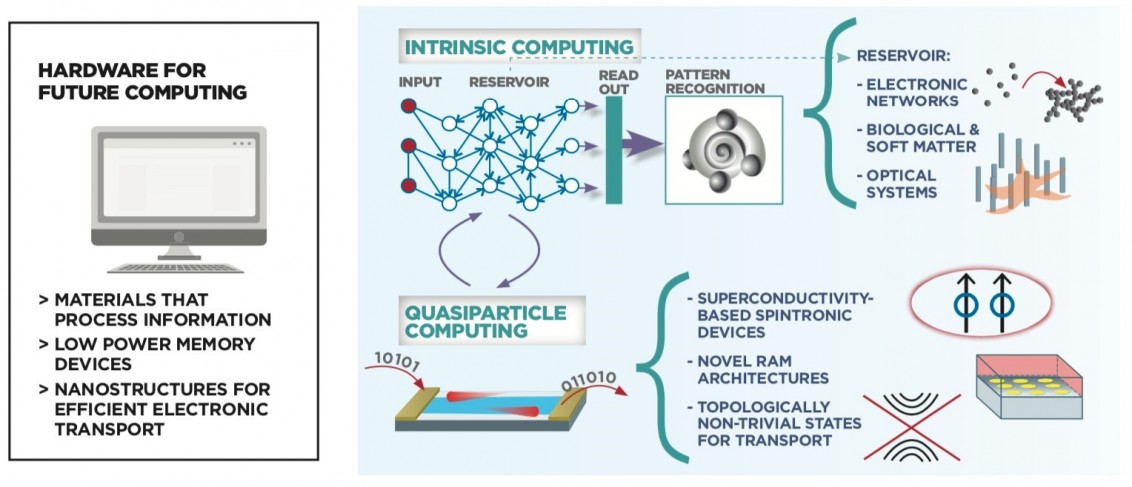
Our vision for materials research driving towards low energy computing
Project descriptions
FC-A: Neuromorphic computing devices and systems from optimised electronic and optical networks
Principal Investigators: Martin Allen, Simon Brown, Nicola Gaston, Natalie Plank, Jami Shepherd
From complex networks of nanoparticles and nanostructures we’ll be building devices and systems that can carry out computation like the brain does. We will harness the strongly correlated brain-like patterns of electrical signals in these networks to show their use as reservoir computing systems, able to perform tasks such as pattern recognition and analysis.
First, we will develop improved control over and understanding of the nanoscale materials, networks and devices we have demonstrated in Tranche 1. We will explore electrical manipulation of synapses made from semiconducting metal oxide and carbon nanotube transistors, aiming to achieve spiking events similar in energy scale to those of biological systems. We will investigate a novel method of brain-like computing with ultrasound, optimise and benchmark our neuromorphic computing devices and systems and explore both electrical and optical means of controlling them. Building off these results, we will test our devices and systems out on the most suitable computing tasks.
FC-B: Computing using materials and structures with coupled and hidden internal order
Principal Investigators: Shen Chong, Michele Governale, Simon Granville, Ben Ruck, Daniel Sando
This project builds on our Tranche 1 developments into computing with materials having superconducting, magnetic and topologically ordered properties. While we will continue to improve our understanding and control over the materials that demonstrate these properties, our focus is to now couple these forms of order to achieve the higher levels of control in structures and prototype devices needed for future energy-efficient and fast computing.
We will study coupling superconductors with ferromagnets to control spin triplet supercurrents, needed for ultra-low energy dissipation superconducting electronics in quantum and cryogenic computing. We will seek a full electrical control of superconductivity using ferroelectric/superconductor structures, resulting in switching and rectification devices for superconductor power electronics. We will also theoretically and experimentally investigate members of the growing class of magnetic materials with multipolar order resulting in zero net magnetisation, which include antiferromagnets, altermagnets and fully spin-compensated ferromagnets, opening the door to non-volatile logic, memory and data storage devices that achieve very high densities without the problem of cross-talk from fringe magnetic fields.
PhD scholarships available in Hardware for Future Computing
Full list of PhD scholarships available in Hardware for Future Computing funded by the MacDiarmid Institute and how to apply.
In the news
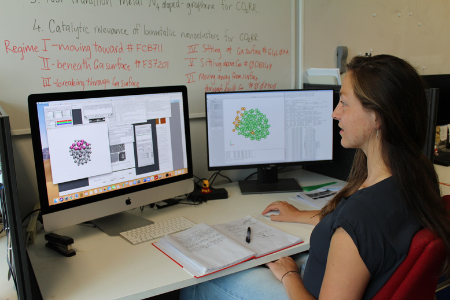
News Article
Liquid metals that create nanostructure - it’s the little details that count
March 8, 2021
PhD candidate and MacDiarmid Institute researcher Stephanie Lambie from successfully kick-started a new collaboration with FLEET.
Read more about Liquid metals that create nanostructure - it’s the little details that count
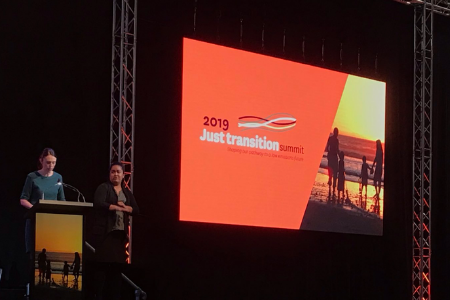
Annual Report
Materials science in the new energy sector
June 11, 2020
In May, the Government hosted the Just Transition summit in Taranaki on preparing for a low emissions economy,
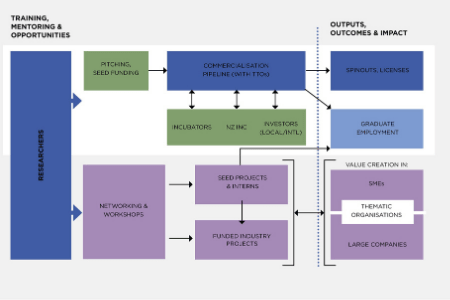
Annual Report
An integrated research commercialisation approach
June 11, 2020
Our efforts towards supporting emerging science entrepreneurs links students, experienced researchers, industry and investors across the country.
Read more about An integrated research commercialisation approach
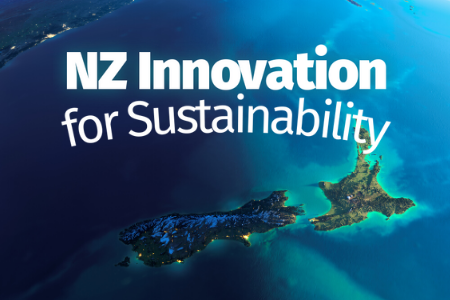
Annual Report
How can materials science offer a greener future for our planet? - Annual Report 2019
May 28, 2020
In 2019, we focused our annual regional showcase on 'NZ Innovation for Sustainability.'

Annual Report
New Associate Investigators 2019 - Annual Report 2019
May 28, 2020
An overview of the research interests of each of our nine new Associate Investigators.
Read more about New Associate Investigators 2019 - Annual Report 2019
Videos
Lasers, Milk and Sperm - Cather Simpson
March 21, 2019
Professor, Associate Investigator, and Director of the Photon Factory, Cather Simpson talks about her work in photonics and how her curiosity about how materials behave at the nanoscale has positive implications on the economy and our health and wellbeing.
Alison Downard - hi-tech painting
March 21, 2019
Professor Alison Downard, a researcher at the MacDiarmid Institute and the University of Canterbury explains "hi-tech painting" techniques to develop surface coatings to boost the effectiveness of energy storing devices.
SAVVY Express: Science Media Centre - MacDiarmid Institute
MacDiarmid Institute alumna Dr Rebecca Hawke: researching new solar cells
February 25, 2019
Physicist and MacDiarmid Institute alumna Dr Rebecca Hawke talks about solar cells and where science has taken her around the world.
This video includes captions.
1. Where in the world would you study science?
2. What are 5 items you can see around you that materials scientists worked on?
Read more MacDiarmid Institute alumna Dr Rebecca Hawke: researching new solar cells
2017 Lecture Series: Women in nanoscience
February 16, 2019
In the 2017 MacDiarmid Institute Regional Lecture Series: Women in nanoscience, three female MacDiarmid Institute nanoscientists tell their personal stories of life in science. Professors Penny Brothers and Cather Simpson, and Dr Michelle Dickinson (aka Nanogirl) give their own perspectives on what it is like being a woman in the physical sciences (physics, chemistry or engineering).
2018 Lecture Series: MacDiarmid - to Industry and Beyond!
February 16, 2019
In the 2018 MacDiarmid Institute Regional Lecture Series: MacDiarmid - to Industry and Beyond! Associate Professor Ben Ruck and Dr Harry Warring talk about their lives and work.
Read more 2018 Lecture Series: MacDiarmid - to Industry and Beyond!
Podcasts
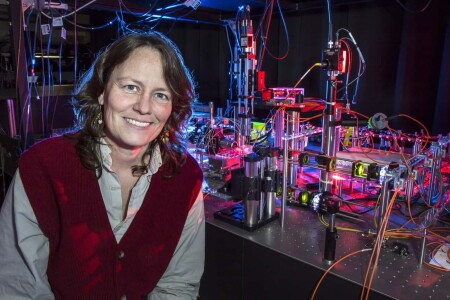
MacDiarmid Investigators Cather Simpson and David Williams discuss how materials science is changing the way farmers analyse milk – Our Changing World
May 9, 2019
MacDiarmid Investigators Cather Simpson and David Williams discuss how materials science is changing the way farmers analyse milk – Our Changing World.

